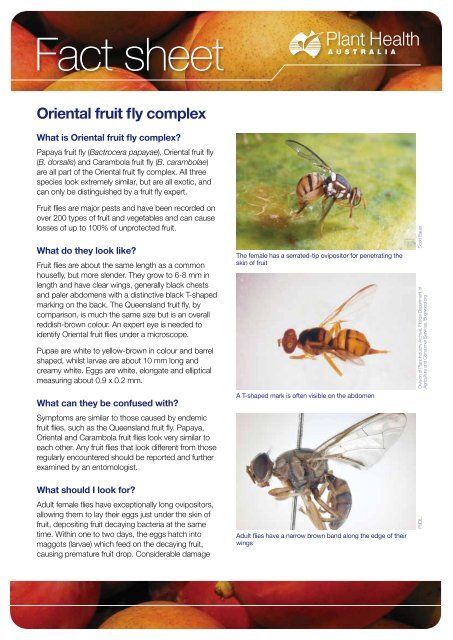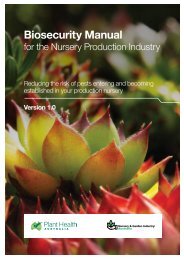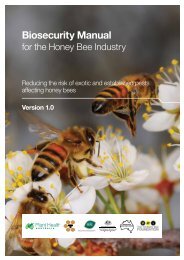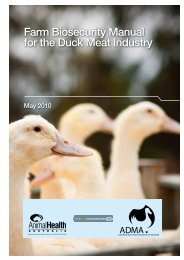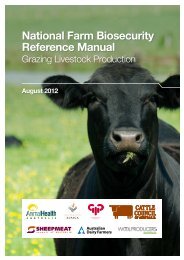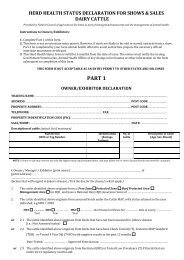Orchard Biosecurity Manual for the Mango Industry - Farm Biosecurity
Orchard Biosecurity Manual for the Mango Industry - Farm Biosecurity
Orchard Biosecurity Manual for the Mango Industry - Farm Biosecurity
You also want an ePaper? Increase the reach of your titles
YUMPU automatically turns print PDFs into web optimized ePapers that Google loves.
Fact sheets<br />
Fact sheet<br />
Oriental fruit fly complex<br />
What is Oriental fruit fly complex?<br />
Papaya fruit fly (Bactrocera papayae), Oriental fruit fly<br />
(B. dorsalis) and Carambola fruit fly (B. carambolae)<br />
are all part of <strong>the</strong> Oriental fruit fly complex. All three<br />
species look extremely similar, but are all exotic, and<br />
can only be distinguished by a fruit fly expert.<br />
Fruit flies are major pests and have been recorded on<br />
over 200 types of fruit and vegetables and can cause<br />
losses of up to 100% of unprotected fruit.<br />
What do <strong>the</strong>y look like?<br />
Fruit flies are about <strong>the</strong> same length as a common<br />
housefly, but more slender. They grow to 6-8 mm in<br />
length and have clear wings, generally black chests<br />
and paler abdomens with a distinctive black T-shaped<br />
marking on <strong>the</strong> back. The Queensland fruit fly, by<br />
comparison, is much <strong>the</strong> same size but is an overall<br />
reddish-brown colour. An expert eye is needed to<br />
identify Oriental fruit flies under a microscope.<br />
Pupae are white to yellow-brown in colour and barrel<br />
shaped, whilst larvae are about 10 mm long and<br />
creamy white. Eggs are white, elongate and elliptical<br />
measuring about 0.9 x 0.2 mm.<br />
What can <strong>the</strong>y be confused with?<br />
Symptoms are similar to those caused by endemic<br />
fruit flies, such as <strong>the</strong> Queensland fruit fly. Papaya,<br />
Oriental and Carambola fruit flies look very similar to<br />
each o<strong>the</strong>r. Any fruit flies that look different from those<br />
regularly encountered should be reported and fur<strong>the</strong>r<br />
examined by an entomologist.<br />
What should I look <strong>for</strong>?<br />
Adult female flies have exceptionally long ovipositors,<br />
allowing <strong>the</strong>m to lay <strong>the</strong>ir eggs just under <strong>the</strong> skin of<br />
fruit, depositing fruit decaying bacteria at <strong>the</strong> same<br />
time. Within one to two days, <strong>the</strong> eggs hatch into<br />
maggots (larvae) which feed on <strong>the</strong> decaying fruit,<br />
causing premature fruit drop. Considerable damage<br />
The female has a serrated-tip ovipositor <strong>for</strong> penetrating <strong>the</strong><br />
skin of fruit<br />
A T-shaped mark is often visible on <strong>the</strong> abdomen<br />
Adult flies have a narrow brown band along <strong>the</strong> edge of <strong>the</strong>ir<br />
wings<br />
Scott Bauer<br />
Division of Plant <strong>Industry</strong> Archive, Florida Department of<br />
Agriculture and Consumer Services, Bugwood.org<br />
PaDIL


